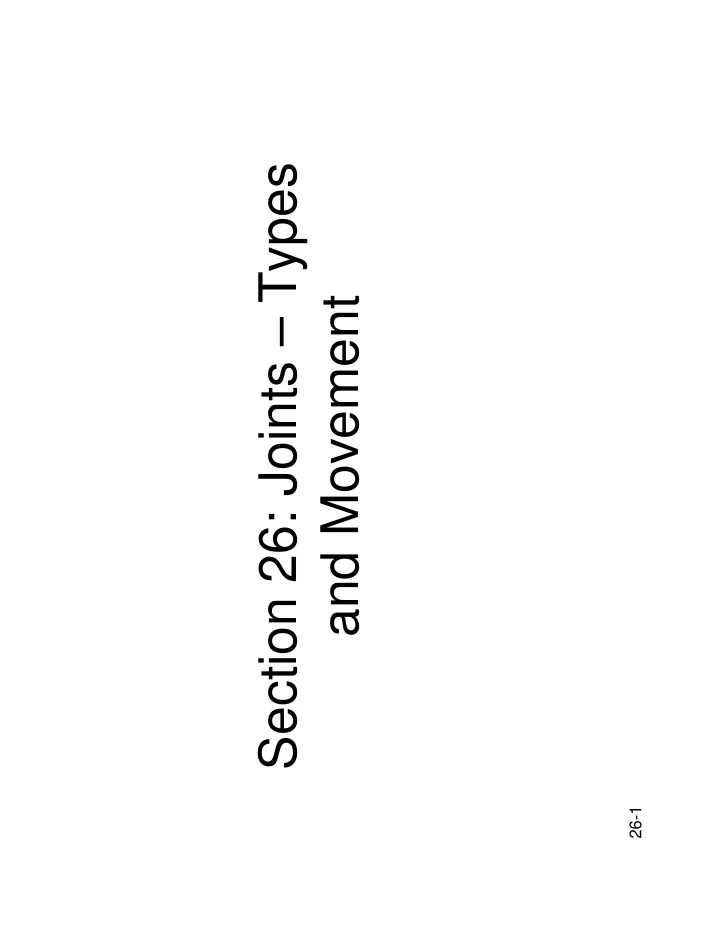

Section 26: Joints – Types and Movement 26-1
Synovial joints: stability Synovial joints: stability • Stability is determined by: Stability is determined by: – Articular surfaces – shape determines what movements are possible movements are possible – Ligaments – unite bones and prevent excessive or undesirable motion excessive or undesirable motion – Muscle tone 26-2 From: Mathis
Synovial joints: stability Synovial joints: stability • Muscle tone is accomplished by: Muscle tone is accomplished by: – Muscle tendons across joints acting as stabilizing factors stabilizing factors – Tendons that are kept tight at all times by muscle tone muscle tone 26-3 From: Mathis
Terms • Pivot Point – The point that the joints rotate about. • The fundamental movements are roll, slide, and spin. 26-4 From: IPRO
More Terms More Terms • Motion – Either active or passive Motion Either active or passive – Active is the patients movement of his or her arm – Passive is the examiners movement of the patient’s p arm • Extension – Natural movement opposite to flexion at the zero position. • Hyperextension – Unnatural motion opposite to fl flexion at the zero position. i t th iti 26-5 From: IPRO
From: Hoxha 26-6
Types of synovial joints Types of synovial joints • Hinge joints Hinge joints – Cylindrical projections of one bone fits into a trough-shaped surface on another trough shaped surface on another – Motion is along a single plane – Uniaxial joints permit flexion and extension – Uniaxial joints permit flexion and extension only 26-7 From: Mathis
Hinge Joint Hinge Joint An example of a hinge joint is the elbow joint. 26-8 From: IPRO
Hinge Joints Hinge Joints • The knee joint The knee joint • In the knee joint the femur articulates with the tibia. • The patella (knee cap) helps to give a better angle p g g of pull. • The fibula is not part of the knee joint and so the tibia is the weight bearing bone. 26-9 From: Essex
From: Mathis 26-10
• A ball-and-socket joint consists of a ball A ball and socket joint consists of a ball (head) inserted into a socket. Movement is multiaxial allowing movement in almost multiaxial allowing movement in almost any direction 26-11 From: Hoxha
Ball-and-Socket joints Ball and Socket joints • A spherical or hemispherical head of one A spherical or hemispherical head of one bone articulates with a cuplike socket of another another • Multiaxial joints permit the most freely moving synovial joints moving synovial joints 26-12 From: Mathis
Ball-and-Socket Joint Ball and Socket Joint An example of a ball-and-socket joint is the hip joint. 26-13 From: IPRO
Ball & socket joints Ball & socket joints • The hip joint p j • The head of the femur fits into a deep cavity called the acetabulum on the pelvic bone. t b l th l i b • This deep cavity gives the hip joint stability. joint stability. • The presence of strong ligaments add to the stability making it difficult to dislocate the ki it diffi lt t di l t th hip. 26-14 From: Essex
From: Mathis 26-15
Hip Joint ROM Hip Joint ROM From: IPRO 26-16
Knee Joint ROM Knee Joint ROM From: IPRO 26-17
Angular movements Angular movements • Angular movements involve changing the Angular movements involve changing the angle between two parts of the body • Found in most of all our limb joints • Found in most of all our limb joints 26-18 From: Hoxha
Flexion / Extension Flexion / Extension • Flexion means to bend (decrease the Flexion means to bend (decrease the angle) • Extension means to straighten (increase • Extension means to straighten (increase the angle) 26-19 From: Hoxha
From: Hoxha 26-20
Recommend
More recommend